New tools for reusable rubber
 Australian researchers are working on new methods to recycle rubber over and again.
Australian researchers are working on new methods to recycle rubber over and again.
Flinders University researchers have described a rubber polymer made from sulphur and canola oil, which can be compressed and heated with fillers to create construction materials of the future.
Cement is a finite resource and heavily polluting in its production, with concrete production estimated to contribute more than 8 per cent of global greenhouse gases emissions, and the construction industry worldwide accounting for about 18 per cent.
“This new recycling method and new composites are an important step forward in making sustainable construction materials, and the rubber material can be repeatedly ground up and recycled,” says lead author Flinders PhD Nic Lundquist.
“The rubber particles also can be first used to purify water and then repurposed into a rubber mat or tubing.
“This is also important because there are currently few methods to recycle PVC or carbon fibre.”
The new manufacturing and recycling technique, labelled ‘reactive compression moulding’, applies to rubber material that can be compressed and stretched, but one that does not melt.
The unique chemical structure of the sulphur backbone in the novel rubber allows for multiple pieces of the rubber to bond together.
The powdered rubber can potentially be used as tubing, rubber coatings or bumpers, or compressed, heated then mixed with other fillers to form entirely new composites, including more sustainable building blocks, concrete replacement or insulation.
“This method could produce materials that may one day replace non-recyclable construction materials, bricks and even concrete replacement,” says organic chemistry researcher Associate Professor Justin Chalker.








 Print
Print